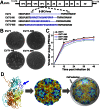Rational design of thermostable vaccines by engineered peptide-induced virus self-biomineralization under physiological conditions
- PMID: 23589862
- PMCID: PMC3651461
- DOI: 10.1073/pnas.1300233110
Rational design of thermostable vaccines by engineered peptide-induced virus self-biomineralization under physiological conditions
Abstract
The development of vaccines against infectious diseases represents one of the most important contributions to medical science. However, vaccine-preventable diseases still cause millions of deaths each year due to the thermal instability and poor efficacy of vaccines. Using the human enterovirus type 71 vaccine strain as a model, we suggest a combined, rational design approach to improve the thermostability and immunogenicity of live vaccines by self-biomineralization. The biomimetic nucleating peptides are rationally integrated onto the capsid of enterovirus type 71 by reverse genetics so that calcium phosphate mineralization can be biologically induced onto vaccine surfaces under physiological conditions, generating a mineral exterior. This engineered self-biomineralized virus was characterized in detail for its unique structural, virological, and chemical properties. Analogous to many exteriors, the mineral coating confers some new properties on enclosed vaccines. The self-biomineralized vaccine can be stored at 26 °C for more than 9 d and at 37 °C for approximately 1 wk. Both in vitro and in vivo experiments demonstrate that this engineered vaccine can be used efficiently after heat treatment or ambient temperature storage, which reduces the dependence on a cold chain. Such a combination of genetic technology and biomineralization provides an economic solution for current vaccination programs, especially in developing countries that lack expensive refrigeration infrastructures.
Keywords: genetic engineering; shell; vaccine design.
Conflict of interest statement
The authors declare no conflict of interest.
Figures





References
-
- Rappuoli R, Miller HI, Falkow S. Medicine. The intangible value of vaccination. Science. 2002;297(5583):937–939. - PubMed
-
- Chen X, et al. Improving the reach of vaccines to low-resource regions, with a needle-free vaccine delivery device and long-term thermostabilization. J Control Release. 2011;152(3):349–355. - PubMed
-
- Clemens J, Holmgren J, Kaufmann SH, Mantovani A. Ten years of the Global Alliance for Vaccines and Immunization: Challenges and progress. Nat Immunol. 2010;11(12):1069–1072. - PubMed
-
- Schlehuber LD, et al. Towards ambient temperature-stable vaccines: The identification of thermally stabilizing liquid formulations for measles virus using an innovative high-throughput infectivity assay. Vaccine. 2011;29(31):5031–5039. - PubMed
Publication types
MeSH terms
Substances
LinkOut - more resources
Full Text Sources
Other Literature Sources

